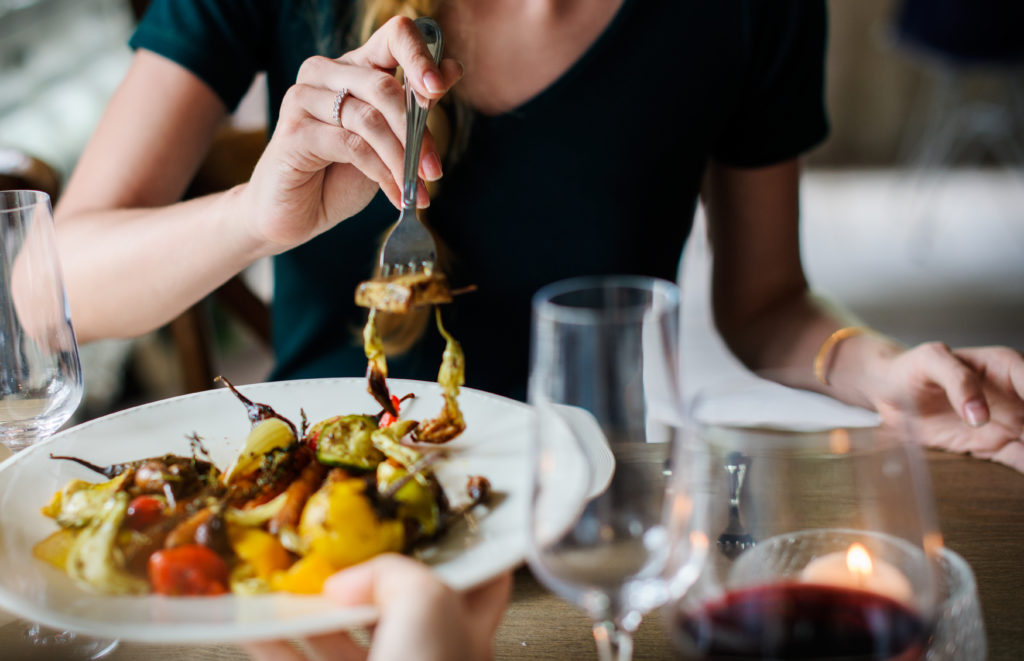The home in Italy is sacred, and the dinner table is the high altar. Dinners are a daily rite of both eating well and being present with friends and family.
All of Italy agrees that food and wine brings friends and family together, no matter where you are. So block off an evening, gather your loved ones, and follow these steps to prepare a meal the Italian way.
First Things First …
The first rule is sacrosanct: dinner must be enjoyable. It must never be rushed, typically beginning around eight and ending a few hours later.
Three important ingredients are present in every Italian dinner: olive oil, bread, wine.
- Olive oil, fresh and locally sourced, is a must.
- A fresh loaf of bread should adorn every Italian table.
- Regional wine, both white and red, accompanies food year-round. White wine is obligatory in summer; red wine is rarely served on a hot day. Italian red wine is full-bodied and full of Italian sunshine.
8 Steps to the Perfect Italian Dinner Party
Your Italian dinner party should consist of the following courses:
- Aperitivo (appetizer)
- Antipasto (before the meal)
- Primo (first course)
- Secondo (second course)
- Contorno (side dish, served alongside the secondo)
- Dolce (dessert)
- Caffè
- Digestivo (cordial)
The aperitivo (appetizer)
The aperitivo is the appetizer, but don’t think buffalo wings or mozzarella cheese sticks. The classic option is prosecco, the fun Italian cousin of Champagne, or an Aperol spritz. Light nibbles may accompany the aperitivo: crackers, a bowl of shelled nuts, or even potato chips or popcorn.
Antipasto (before the meal)
Antipasto, literally “before the meal,” means thinly sliced, cured Italian meat, and cheese. Every region has its specialties, but standbys include prosciutto, pecorino cheese, and parmesan cheese in fresh chunks, accompanied by olives.
Pair them with grissini, the thin, hard breadsticks from Turin, or small squares of focaccia or schiacciata, the tender flatbread dressed with olive oil known throughout Italy. Crostini are ubiquitous toast points typically spread with chicken liver pâté or simple olive oil and salt. Bruschetta is a type of crostini topped with chopped tomatoes, olive oil, and salt.
Serve antipasto family-style, on large platters, with small plates for guests.
Primo (first course)
The primo is the first course. Typical options are a fresh zuppa (soup) or fresh pasta. Pasta is dressed — not drowning — in a straightforward sauce or homemade ragù made with veal, rabbit or pancetta (pork belly). Pasta should be cooked carefully al dente, with a firm texture.
Always set out freshly grated parmesan. If serving pasta, go for a solid red sangiovese or Valpolicella. Warm outside? Uncork your chilled white pinot grigio.
Secondo (second course)
The secondo is the meat course, varying widely by region and season. Offer a tagliata (literally, “sliced”) flank, hanger, or sirloin steak — seared on high heat to be dark on the outside and rare and tender on the inside — atop a bed of fresh arugula and dressed with olive oil, rosemary, and sea salt. Or, opt to roast a whole pollo (chicken) until fork-tender.
For wine, consider a Montepulciano or amarone to complement the roasted meat.
Contorno (side dish)
Roasted potatoes are a frequent contorno, or side dish — crispy outside, creamy inside. The contorno might also feature steamed spinach or a dark-green side salad. Thinly sliced and grilled eggplant and red pepper are also traditional options. Season all vegetables with olive oil and salt.
Dolce (dessert)
Italians dolce (dessert) might be artisanal gelato or a semifreddo, a partially frozen creamy custard. Seasonal crostate (tarts) filled with berries, apples, or pears are always deliziose.
Caffè
Italians invariably take an espresso at the end of the meal and always serve it black when the hour is late. Decaf is acceptable.
Italians are puzzled when foreigners order a cappuccino instead of coffee or espresso at the end of the meal. Italians don’t drink cappuccino late in the day because it contains milk, which is reserved for the breakfast hour.
Digestivo (cordial)
Finally, the digestivo arrives in a cordial glass — a quick nip of liquor to aid digestion. Potent grappa is the classic choice, like Grappa Nonino. Amari (bitters) are popular, along with Cynar, an artichoke-based digestivo with a retro appeal that has surged in recent years. If you prefer something more sweet than strong, you can opt for a taste of Italy’s iconic limoncello.
Follow these guidelines to plan the perfect Italian dinner party and watch your guests light up. Trust the Italians on this — they’ve been hosting successful meals for centuries.
Looking to add more Italian charm to your life? Spruce up your kitchen with these simple Italian touches, or take our quiz to see how much you really know about Italian culture.
—
Monica Sharp is a writer and advocate for the arts who has traveled in more than forty countries. She currently lives in Florence, Italy, with her husband and two young children.


